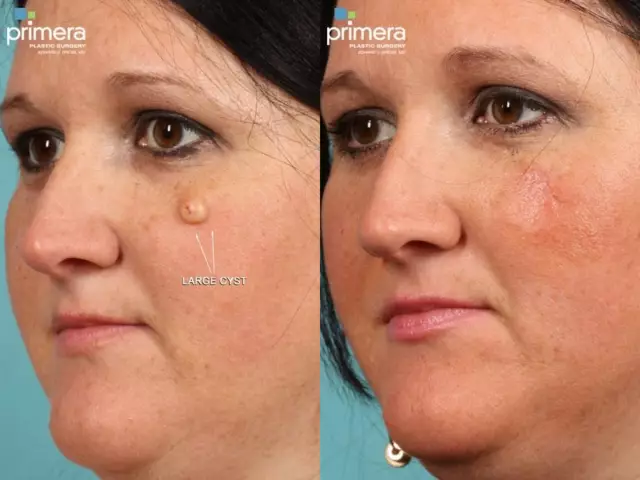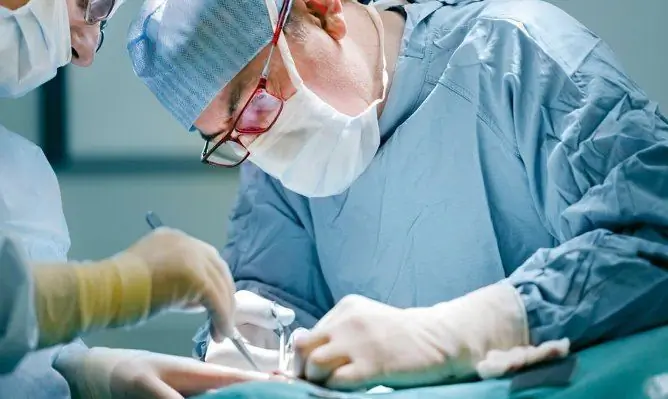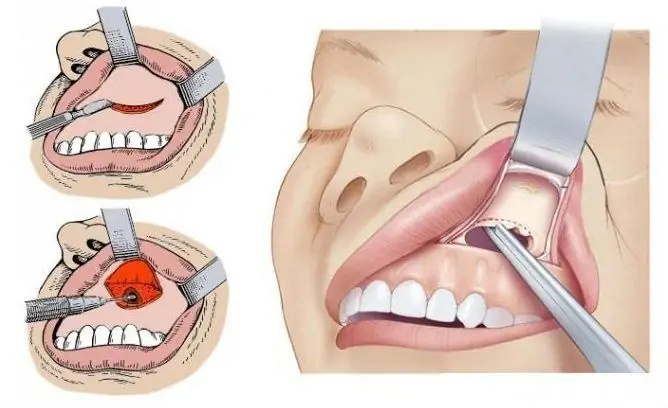- Author Rachel Wainwright [email protected].
- Public 2023-12-15 07:39.
- Last modified 2025-11-02 20:14.
Endometrioid cyst

Endometrioid cyst is a benign ovarian neoplasm. With ovarian endometriosis, small lesions grow, merge with each other, forming cysts. Endometrioid cysts are covered with a dense capsule and are often filled with menstrual blood. They can be both unilateral and bilateral. Their size can vary from one to ten centimeters in diameter. This pathology is most often diagnosed in women aged 12 to 50 years.
The causes of the endometrioid ovarian cyst
The exact cause of this disease is not fully understood. It is believed that a cyst can form as a result of retrograde menstruation. Endometrial cells during this period are transported with blood. They can take root in the abdominal cavity, in the tissues of the ovaries, in the fallopian tubes. Endometrial cells can get into during medical abortion, diagnostic curettage, gynecological operations, as well as during diathermocoagulation of the cervix.
Some doctors believe that the endometrioid ovarian cyst is formed with persistent replacement of the remnants of embryonic tissue or as a result of any genetic defects, weakening of immune responses. The connection between endocrine disruptions and the development of this disease has been proven.
Emotional stresses, prolonged use of intrauterine devices, liver disease, endometritis, obesity, oophoritis, as well as an unfavorable environmental situation can provoke the development of this pathology.
Symptoms of an endometrioid ovarian cyst
The severity of the symptoms of the disease depends on the degree of neglect of the cyst, on the presence of concomitant pathologies, as well as on the psychological state of the patient.
The development of the disease can be accompanied by a lengthening of the monthly cycle, the appearance of smearing discharge before and after the menstrual cycle, the appearance of symptoms of body intoxication (nausea, weakness), and an increase in body temperature.
An increase in cyst size can lead to scarring and follicular cysts. They interfere with the normal functioning of the ovary and lead to oocyte degeneration. Without treatment, an endometrioid cyst can be the cause of the development of an adhesions in the pelvic organs, leading to dysfunction of the intestines and bladder.
Diagnosis and treatment of endometrioid ovarian cysts
This pathology cannot be detected independently. Often, a doctor detects an ovarian cyst during a gynecological examination. To clarify the diagnosis, laparoscopy, ultrasound of the small pelvis with magnetic resonance imaging and dopplerometry are usually prescribed.
For the treatment of endometrioid cysts, conservative methods can be used (analgesic, non-specific anti-inflammatory, hormonal therapy, intake of enzymes, vitamins and immunomodulators), surgical (organ-preserving removal of the methyroid cyst by the laparoscopic or laparotomic method) and combined.
Treatment of a cyst should be aimed at eliminating the symptoms of the disease, as well as preventing its progression.
The tactics of treating this pathology must be chosen taking into account the patient's age, the stage of development of the disease, the presence or absence of problems with conception, as well as extragenital and genital disorders.
Removal of the endometrioid cyst

The operation for an endometrioid cyst is carried out with the ineffectiveness of conservative methods of therapy, with large cysts, and also with the risk of complications. Enucleation of heterotropic formations and ovarian resection are the most common surgical methods for treating the disease. The most sparing operation for endometrioid cysts is laparoscopy. Recovery from laparoscopy is very short.
Removal of the endometrioid cyst is necessarily carried out in combination with hormone therapy. The doctor may prescribe low-dose monophasic combined contraceptives, norsteroid derivatives, long-acting medroxyprogesterone acetate, synthetic gonadotropin-releasing hormone agonists, and androgen derivatives.
After surgery to remove the endometrioid cyst, patients are prescribed physiotherapy to correct endocrine balance, prevent infiltration and adhesions and possible recurrence of cysts.
Endometrioid cyst and pregnancy
With the development of a cyst, the possibility of getting pregnant is significantly reduced, since due to the inflammatory reaction, part of the follicles is destroyed. Against the background of the disease, hormonal disorders occur both in the ovary and in the hypothalamic-pituitary system. The adhesion process in the small pelvis can contribute to the development of infertility.
With the onset of pregnancy with this disease in the early stages, antispasmodic, hormonal and sedative drugs are usually prescribed. With a small size of the endometrioid cyst during pregnancy, surgery is not required. With a large cyst, the risk of rupture of the cyst or twisting of its legs, spontaneous termination of pregnancy increases.
YouTube video related to the article:
The information is generalized and provided for informational purposes only. At the first sign of illness, see your doctor. Self-medication is hazardous to health!






